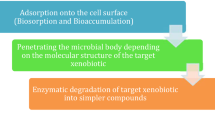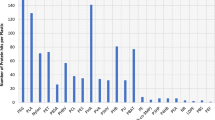Abstract
A soil bacterium capable of utilizing methyl parathion as sole carbon and energy source was isolated by selective enrichment on minimal medium containing methyl parathion. The strain was identified as belonging to the genus Serratia based on a phylogram constructed using the complete sequence of the 16S rRNA. Serratia sp. strain DS001 utilized methyl parathion, p-nitrophenol, 4-nitrocatechol, and 1,2,4-benzenetriol as sole carbon and energy sources but could not grow using hydroquinone as a source of carbon. p-Nitrophenol and dimethylthiophosphoric acid were found to be the major degradation products of methyl parathion. Growth on p-nitrophenol led to release of stoichiometric amounts of nitrite and to the formation of 4-nitrocatechol and benzenetriol. When these catabolic intermediates of p-nitrophenol were added to resting cells of Serratia sp. strain DS001 oxygen consumption was detected whereas no oxygen consumption was apparent when hydroquinone was added to the resting cells suggesting that it is not part of the p-nitrophenol degradation pathway. Key enzymes involved in degradation of methyl parathion and in conversion of p-nitrophenol to 4-nitrocatechol, namely parathion hydrolase and p-nitrophenol hydroxylase component “A” were detected in the proteomes of the methyl parathion and p-nitrophenol grown cultures, respectively. These studies report for the first time the existence of a p-nitrophenol hydroxylase component “A”, typically found in Gram-positive bacteria, in a Gram-negative strain of the genus Serratia.



Similar content being viewed by others
References
Barnes H, Folkard AR (1951) The determination of nitrites. Analyst 76:599–603
Benning MM, Kuo JM, Raushel FM, Holden HM (1994) Three-dimensional structure of phosphotriesterase: an enzyme capable of detoxifying organophosphate nerve agents. Biochemistry 33:15001–15007
Bradford MM (1976) A rapid and sensitive method for the quantitation of microgram quantities of protein utilizing the principle of protein-dye binding. Anal Biochem 72:248–254
Brown KA (1980) Phosphotriesterases of Flavobacterium sp. Soil Biol Biochem 12:105–112
Cassidy MB, Lee H, Trevors JT, Zablotowicz RB (1999) Chlorophenol and nitrophenol metabolism by Sphingomonas sp. UG 30. J Ind Microbiol Biotechnol 23:232–241
Chaudhry GR, Ali AN, Wheeler WB (1988) Isolation of a methyl parathion-degrading Pseudomonas sp. that possesses DNA homologous to the opd gene from a Flavobacterium sp. Appl Environ Microbiol 54:288–293
Chauhan A, Samanta SK, Jain RK (2000) Degradation of 4-nitrocatechol by Burkholderia cepacia: a plasmid-encoded novel pathway. J Appl Microbiol 88:764–772
Chen WX, Tan ZY, Gao JL, Li Y, Wang ET (1997) Rhizobium hainanense sp. nov., isolated from tropical legumes. Int J Syst Bacteriol 47:870–873
Cho CM, Mulchandani A, Chen W (2004) Altering the substrate specificity of organophosphorus hydrolase for enhanced hydrolysis of chlorpyrifos. Appl Environ Microbiol 70:4681–4685
Daubaras DL, Saido K, Chakrabarty AM (1996) Purification of Hydroxyquinol 1,2-dioxygenase and Maleylacetate reductase: the lower pathway of 2,4,5-trichlorophenoxyacetic acid metabolism by Burkholderia cepacia AC1100. Appl Environ Microbiol 62:4276–4279
Duffes F, Jenoe P, Boyaval P (2000) Use of two-dimensional electrophoresis to study differential protein expression in divercin V41-resistant and wild-type strains of Listeria monocytogenes. Appl Environ Microbiol 66:4318–4324
Errampalli D, Tresse O, Lee H, Trevors JT (1999) Bacterial survival and mineralization of p-nitrophenol in soil by green fluorescent protein-marked Moraxella sp. G21 encapsulated cells. FEMS Microbiol Ecol 30:229–236
Harper LL, Mcdaniel CS, Miller CE, Wild JR (1988) Dissimilar plasmids isolated from Pseudomonas diminuta MG and a Flavobacterium sp. (ATCC 27551) contain identical opd genes. Appl Environ Microbiol 54:2586–2589
Hayatsu M, Hirano M, Tokuda S (2000) Involvement of two plasmids in Fenitrothion degradation by Burkholderia sp. strain NF100. Appl Environ Microbiol 66:1737–1740
Jain RK, Dreisbach JH, Spain JC (1994) Biodegradation of p-nitrophenol via 1,2,4-benzenetriol by an Arthrobacter sp. Appl Environ Microbiol 60:3030–3032
Kadiyala V, Spain JC (1998) A two-component monooxygenase catalyzes both the hydroxylation of p-nitrophenol and the oxidative release of nitrite from 4-nitrocatechol in Bacillus sphaericus JS905. Appl Environ Microbiol 64:2479–2484
Kitagawa W, Kimura N, Kamagata Y (2004) A novel p-nitrophenol degradation gene cluster from a gram-positive bacterium, Rhodococcus opacus SAO101. J Bacteriol 186:4894–4902
Leung KT, Tresse O, Errampalli D, Lee H, Trevors JT (1997) Mineralization of p-nitrophenol by pentachlorophenol-degrading Sphingomonas spp. FEMS Microbiol Lett 155:107–114
Leung KT, Campbell S, Gan Y, White DC, Lee H, Trevors JT (1999) The role of the Sphingomonas species UG 30 pentachlorophenol-4-monooxygenase in p-nitrophenol degradation. FEMS Microbiol Lett 173:247–253
Liu H, Zhang J, Wang S, Zhang X, Zhou N (2005) Plasmid-borne catabolism of methylparathion and p-nitrophenol in Pseudomonas sp. strain WBC-3. Biochem Biophys Res Commun 334:1107–1114
Loper JC (1968) Histidinol dehydrogenase from Salmonella typhimurium. Crystallization and composition studies. J Biol Chem 243:3264–3272
Maniatis T, Fritsch EF, Sambrook J (1982) Molecular cloning. A laboratory manual. Cold Spring Harbor Laboratory Press, New York
Mcdaniel CS, Harper LL, Wild JR (1988) Cloning and sequencing of a plasmid-borne gene (opd) encoding a phosphotriesterase. J Bacteriol 170:2306–2311
Mitra D, Vaidyanathan CS (1984) A new 4-nitrophenol 2-hydroxylase from a Nocardia sp. Biochem Int 8:609–615
Mulbry WW, Karns JS (1989) Purification of three parathion hydrolases from gram-negative bacterial strains. Appl Environ Microbiol 55:289–293
Mulbry WW, Karns JS, Kearney PC, Nelson JO, Mcdaniel CS, Wild JR (1986) Identification of a plasmid-borne parathion hydrolase gene from Flavobacterium sp. by southern hybridization with opd from Pseudomonas diminuta. Appl Environ Microbiol 51:926–930
Muller DM, Schlomann M, Reineke W (1996) Maleylacetate reductases in chloroaromatic-degrading bacteria using the modified ortho pathway: comparison of catalytic properties. J Bacteriol 178:298–300
Munnecke DM, Hsieh DP (1976) Pathways of microbial metabolism of parathion. Appl Environ Microbiol 31:63–69
Murray KC, Duggleby J, Sala-Trepat JM, Williams PA (1972) The metabolism of benzoate and methylbenzoates via the meta-cleavage pathway by Pseudomonas arvilla mt-2. Eur J Biochem 28:301–310
Prakash D, Chauhan A, Jain RK (1996) Plasmid-encoded degradation of p-nitrophenol by Pseudomonas cepacia. Biochem Biophys Res Commun 224:375–381
Ramanathan MP, Lalithakumari D (1999) Complete mineralization of methylparathion by Pseudomonas sp. A3. Appl Biochem Biotechnol 80:1–12
Rani NL, Lalithakumari D (1994) Degradation of methyl parathion by Pseudomonas putida. Can J Microbiol 40:1000–1006
Roldan MD, Blasco R, Caballero FJ, Castillo F (1998) Degradation of p-nitrophenol by the phototrophic bacterium Rhodobacter capsulatus. Arch Microbiol 169:36–42
Serdar CM, Murdock DC, Rohde MF (1989) Parathion hydrolase gene from Pseudomonas diminuta MG: subcloning, complete nucleotide sequence, and expression of the mature portion of the enzyme in Escherichia coli. Biotechnology 7:1151–1155
Siddaramappa R, Rajaram KP, Sethunathan N (1973) Degradation of parathion by bacteria isolated from flooded soil. Appl Microbiol 26:846–849
Singh BK, Walker A (2006) Microbial degradation of organophosphorus compounds. FEMS Microbiol Rev 30:428–471
Somara S, Siddavattam D (1995) Plasmid mediated organophosphate pesticide degradation by Flavobacterium balustinum. Biochem Mol Biol Int 36:627–631
Spain JC, Gibson DT (1991) Pathway for biodegradation of p-nitrophenol in a Moraxella sp. Appl Environ Microbiol 57:812–819
Takeo M, Yasukawa T, Abe Y, Nihara S, Marda Y, Negoro S (2003) Cloning and characterization of a 4-nitrophenol hydroxylase gene cluster from Rhodococcus sp. PN1. J Biosci Bioeng 95:139–145
Thompson JD, Gibson TJ, Plewniak F, Jeanmougin F, Higgins DG (1997) The ClustalX windows interface: flexible strategies for multiple sequence alignment aided by quality analysis tools. Nucleic Acids Res 24:4876–4882
Weigent DA, Nester EW (1976) Purification and properties of two aromatic aminotransferases in Bacillus subtilis. J Biol Chem 251:6974–6980
Zhang R, Cui Z, Jaindong J, Jain H, Xiangyang G, Sphunpeng L (2005) Diversity of organophosphorus pesticide degrading bacteria in a polluted soil and conservation of their organophosphorus hydrolase genes. Can J Microbiol 51:337–343
Acknowledgements
We thank Dr. Reddanna for providing GCMS facility and the University Grants Commission, New Delhi and the Department of Science and Technology, New Delhi for providing financial support to carry out the research work. ABP is a recipient of Junior Research Fellowship from UGC, New Delhi. DS is also a recipient of financial support from Institute of Life Sciences. MM is supported by the Biotechnology and Biological Sciences Research Council, UK.
Author information
Authors and Affiliations
Corresponding author
Electronic supplementary materials
Below is the link to the electronic supplementary material.
Fig. 1
Mass spectrum identifying p-nitrophenol, a degradation product of methyl parathion (DOC 48 640 KB)
Fig. 2
Mass spectrum identifying dimethyl thiophosphoric acid, a degradation product of methyl parathion (DOC 43 520 KB)
Fig. 3
Mass spectrum identifying 4-nitrocatechol, a key intermediate in degradation of PNP (DOC 60 928 KB)
Fig. 4
Mass spectrum identifying 1,2,4-benzenetriol, a key intermediate in degradation of PNP (DOC 97 280 KB)
Fig. 5
2D analysis of the proteome of Serratia sp. strain DS001 cells grown in a glucose, b methylparathion, and cp-nitrophenol (DOC 882 688 KB)
Rights and permissions
About this article
Cite this article
Pakala, S.B., Gorla, P., Pinjari, A.B. et al. Biodegradation of methyl parathion and p-nitrophenol: evidence for the presence of a p-nitrophenol 2-hydroxylase in a Gram-negative Serratia sp. strain DS001. Appl Microbiol Biotechnol 73, 1452–1462 (2007). https://doi.org/10.1007/s00253-006-0595-z
Received:
Revised:
Accepted:
Published:
Issue Date:
DOI: https://doi.org/10.1007/s00253-006-0595-z




